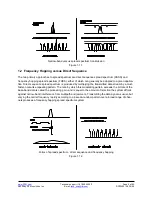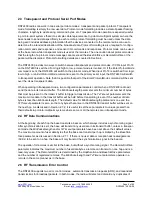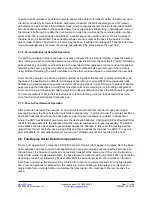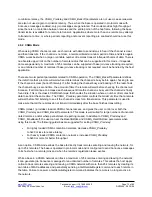
www.RFM.com
Technical s1.678.684.2000
Page 20 of 82
©2009 by RF Monolithics, Inc.
E-mail:
DNT2400 - 08/18/09
For example, consider a TDMA mode 2 system with one remote operating up to 20 miles at 500 kb/s with
the BaseSlotSize parameter set to 64 bytes and the RemoteSlotSize parameter at 64 bytes. As shown in
Figure 2.11.1, the hop duration from the DNT Throughput Calculator program for this configuration is
4.70 ms
Figure 2.11.1
The average full-duplex serial port byte rate that can be supported under error free conditions is:
64 Bytes/4.70 ms = 13.62 kB/s, or 136.2 kb/s for 8N1
Continuous full-duplex serial port data streams at a baud rate of 115.2 k/bs can be supported by this
configuration, provided only occasional RF transmission errors occur. Plan on an average serial port data
flow of 90% of the calculated error-free capacity for general-purpose applications.
The DNT2400 transmit and receive buffers hold at least 1024 bytes and will accept brief bursts of data at
high baud rates, provided the average serial port data flow such as shown in the example above is not
exceeded. It is strongly recommended that the DNT2400 host use hardware flow control in applications
where the transmit buffer can become full. The host must send no more than 32 additional bytes to the
DNT2400 when the DNT2400 de-asserts the host’s CTS line. In turn, the DNT2400 will send no more
than one byte following the host de-asserting its RTS line. Three-wire serial port operation is allowed
through parameter configuration, as discussed in Section 4.2.4. However, data loss is possible under
adverse RF channel conditions when using three-wire serial operation due to buffer overruns.
2.12 Sleep Modes
To save power in applications where a remote transmits infrequently, the DNT2400 supports hardware
and firmware sleep modes. Hardware sleep mode is entered by switching SLEEP/DTR Pin 11 on the
DNT2400 from logic low to high. While in hardware sleep mode, the DNT2400 consumes less than 50 µA
at room temperature. This mode allows a DNT2400 to be powered off while its host device remains
powered. After leaving hardware sleep mode, the radio must re-synchronize with the base and re-
register.
In addition to the sleep mode controlled by Pin 11, in CSMA mode the DNT2400 remotes support an
additional sleep mode to support battery-powered applications. When this mode is enabled, the DNT2400






























